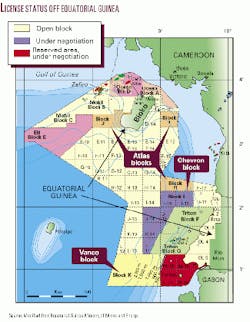Exploration is intensifying in the Rio Muni basin off Equatorial Guinea, West Africa.
Chevron Corp., Vanco Energy Co., Houston, and Atlas Petroleum International Ltd., Lagos, have signed agreements in recent weeks.
One marine tract near shore along the border with Gabon remained under negotiation in mid-May. Other awards are expected to be negotiated one by one until most or all of the acreage is under agreement.
Equatorial Guinea's most recent award was that of Block L to Chevron. The 1,640-sq-mile block extends from 30-110 km off the Bata coast. Water is 200-2,000 m deep.
Under the 5 year production-sharing contract Chevron will open an office in the country later this year and acquire seismic and conduct exploratory drilling.
Chevron (Gulf) drilled Equatorial Guinea's first offshore well, Rio Muni-A1, in 1968. It went to 2,760 m in less than 80 m of water about 27 km northwest of Corisco Island and only 35 km south of the site of Triton Energy Inc. and Energy Africa Ltd.'s late 1999 Ceiba oil and gas discovery. Block L lies west and north of Ceiba.
Chevron produces more than 900,000 b/d of oil and natural gas liquids in West Africa, mainly from Nigeria and Angola.
Meanwhile, Exxon Mobil and Ocean Energy Inc. set a production record at Zafiro field on Block B, where gross volumes averaged 101,500 b/d of oil in first quarter 2000. Jade platform installation was completed, and the first platform development well was to go on production in May. Total output from the greater Zafiro area was initially scheduled to reach 120,000 b/d sometime this year.
Just west of Gabonese and Equatorial Guinean waters and south of Nigerian waters lie 22 deepwater blocks (not shown) covering 12 million acres on which Mobil signed a technical assistance agreement with Sao Tome and Principe in September 1998 (see map, OGJ, Oct. 5, 1998, p. 112). The original agreement has expired, but an industry source said Exxon Mobil retained the right to select blocks pending settlement of a boundary dispute with Nigeria.
Other concessions
Exploration is just starting on several other blocks.
Vanco has purchased considerable speculative seismic data on the Corisco Deep block and plans to acquire about 2,000 sq km of 3D data there during third quarter 2000.
Corisco Deep, covering 1.1 million acres in 200-2,500 m of water, is 24 km southwest of and geologically on trend with Ceiba field in the deepwater Rio Muni trend, an Upper Cretaceous turbidite trend having a structural setting similar to the Ceiba discovery (OGJ, Oct. 18, 1999, p. 90). Corisco Deep also features a number of salt-supported structures of considerable interest, Vanco said.
Vanco's agreement calls for acquisition of 2D and 3D seismic data and drilling of two wells in 5 years. First drilling will likely occur within 2 years.
The company said in late May that it has had expressions of interest from prospective partners. It will consider taking partners after the 3D shoot and might package the Equatorial Guinea interest with stakes in its other West Africa properties. Vanco holds interests off Morocco, Senegal, Ivory Coast, Gabon, and Namibia.
Vanco is a private company that intends to go public after it makes some discoveries in deep water off West Africa, possibly in 2 years or so.
Awards to Atlas involved blocks in three basins off Equatorial Guinea.
Block H lies north of Chevron's Block L in the Rio Muni basin. Block H covers 1,650 sq km in 200-2,000 m of water. Atlas farmed out this block to Roc Oil Co. Ltd., Sydney.
Block I covers 840 sq km in the Douala basin and is in 200-1,200 m of water east of Bioko Island.
Block J west of Bioko covers 1,300 sq km in as much as 1,400 m of water. This block has a distal Niger Delta geologic setting.
Ceiba field progress
At Ceiba field, Triton spudded the Ceiba-3 appraisal well May 1 using Global Marine's R.F. Bauer drill ship. Sedco 700 was expected to arrive by early June to drill/complete wells.
The two rigs will drill and complete more wells as part of Triton's accelerated development program aimed at starting production by yearend 2000. Production components, including the floating production, storage and offloading vessel, are being manufactured and/or refurbished at several locations worldwide.
Triton is analyzing about 8%, or 350 sq km, of the 3D seismic acquired over Ceiba field. The remaining 3,850 sq km of data are being processed and were to be available by the end of May. The seismic data are helping Triton better determine future well sites and prospectivity.


